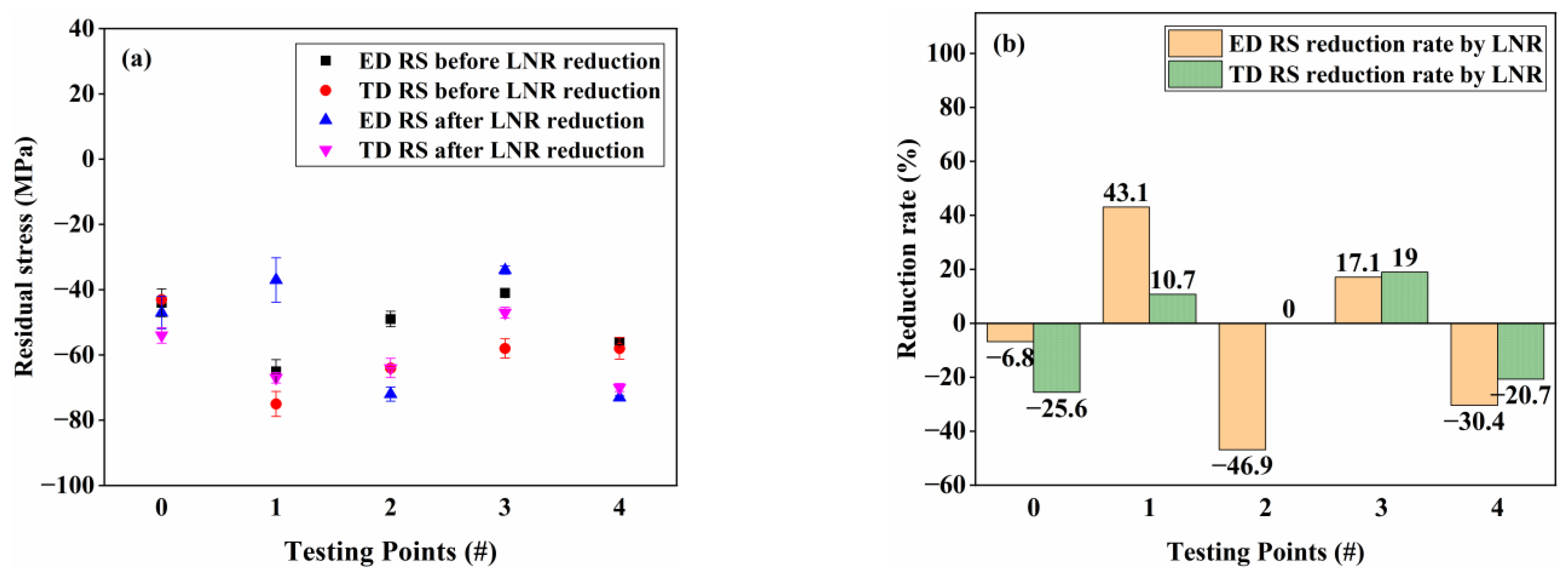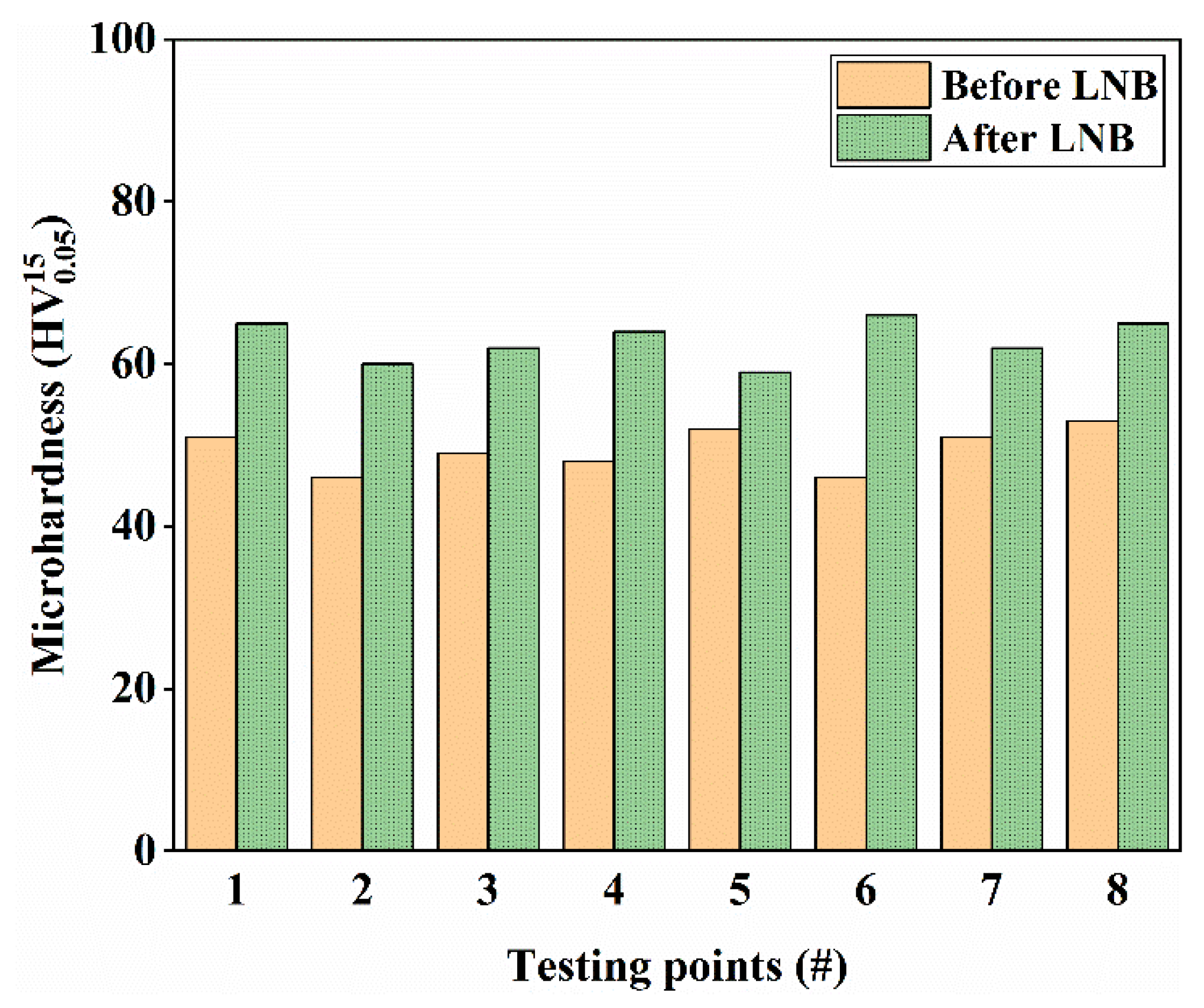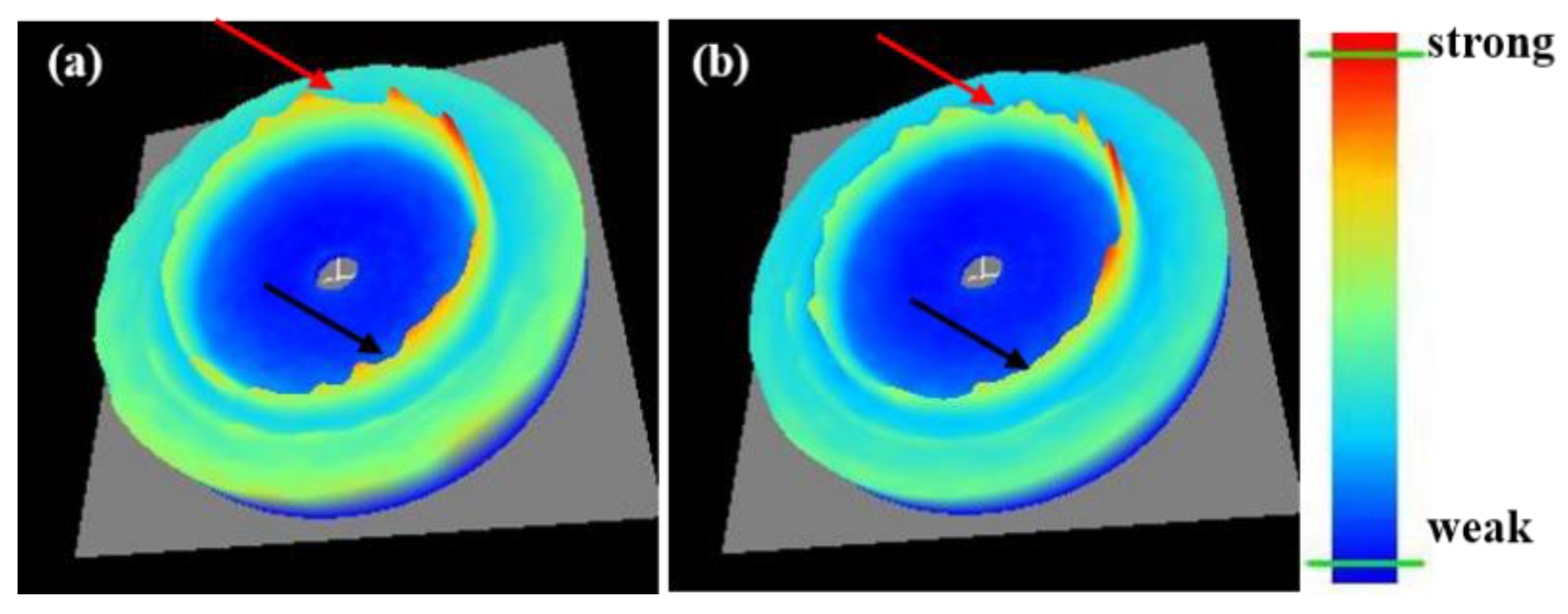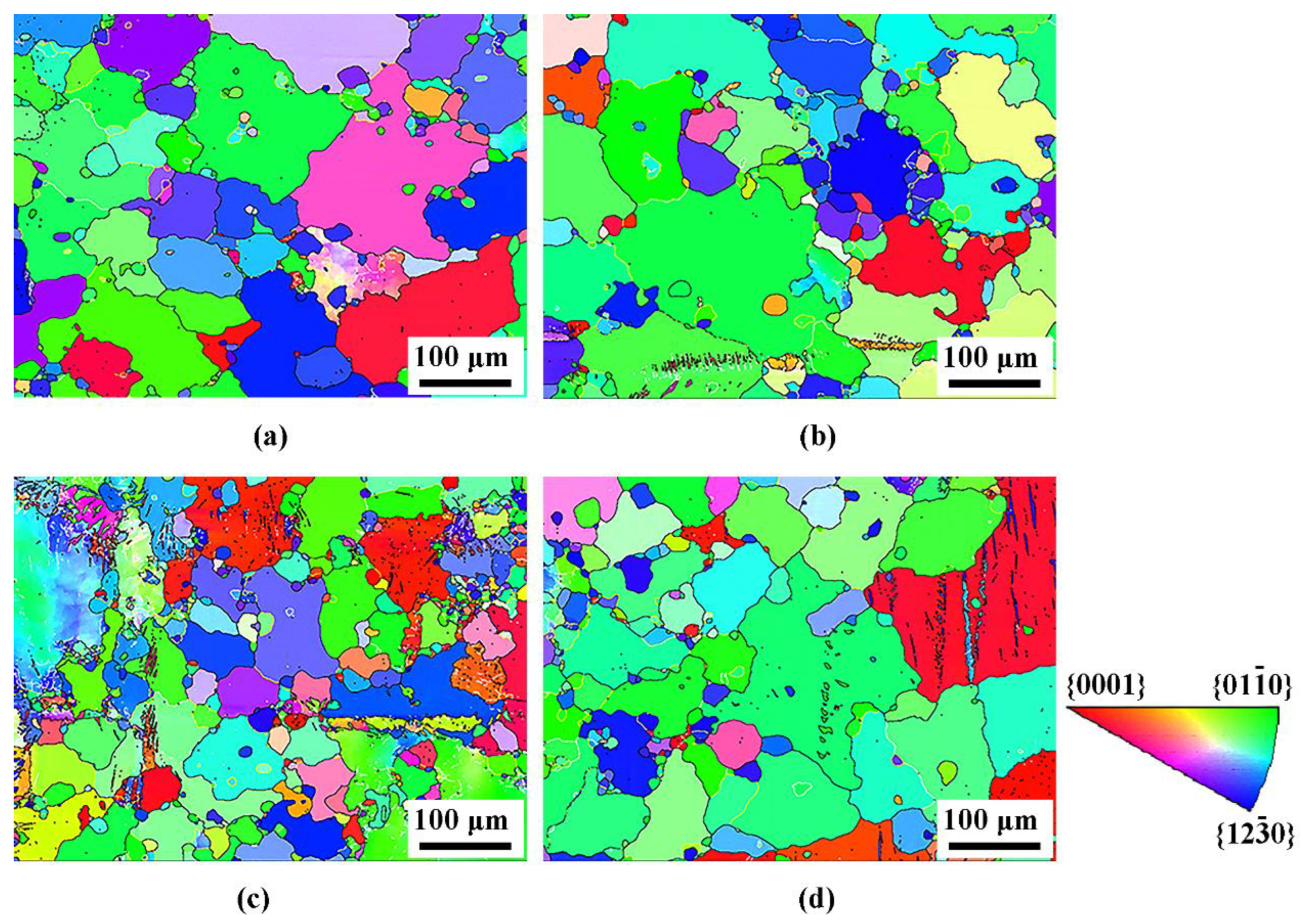Effect of Uphill Quenching on Microstructure and Residual Stress Reduction of AZ31B Magnesium Alloy Plate
Abstract
:1. Introduction
2. Materials and Methods
- (a)
- First deep cryogenic treated in liquid nitrogen (LN) for 0.5 h, then uphill quenched in room temperature water (LNR) of 25 °C for 0.5 h and cooled in air until room temperature at last;
- (b)
- First deep cryogenic treated in liquid nitrogen (LN) for 0.5 h, then uphill quenched in boiling water (LNB) of 100 °C for 0.5 h and cooled in air until room temperature at last;
- (c)
- First deep cryogenic treated in liquid nitrogen (LN) for 0.5 h, then uphill quenched in hot air (LNHA) of 160 °C for 0.5 h and cooled in air until room temperature at last.
3. Results
3.1. Residual Stress
3.2. Microhardness
3.3. Diffraction Analysis
3.4. Microstructure
4. Discussion
5. Conclusions
- (1)
- The residual stress of the magnesium alloy rolling plates was reduced during the three uphill quenching processes. The best effect of residual stress distribution with relief rate of 56% of AZ31B magnesium alloy was obtained by the liquid nitrogen–boiling water process, and the relief rate of the liquid nitrogen–room temperature water process was the lowest.
- (2)
- Uphill quenching treatment was shown to be beneficial to improving the hardness of the material. The hardness of AZ31B magnesium alloy can be increased by about 29% after being treated by the uphill quenching process.
- (3)
- The microstructure of the magnesium alloy rolling plate was refined by the uphill quenching treatment. The variation of crystal plane spacing and temperature field were the main factors to influence the residual stress of uphill quenching.
- (4)
- There must be a certain temperature difference in the uphill quenching. The effect of reducing the temperature below a certain temperature difference was not obvious. The heat exchange coefficient should be large enough to beneficially reduce the residual stress. The liquid nitrogen–room temperature water process has a poor relief effect due to an insufficient temperature difference. The lower liquid nitrogen–hot air heat exchange coefficient resulted in a lower relief rate than that of the liquid nitrogen–boiling water process.
Author Contributions
Funding
Institutional Review Board Statement
Data Availability Statement
Acknowledgments
Conflicts of Interest
References
- Luo, A.A. Magnesium casting technology for structural applications. J. Magnes. Alloy. 2013, 1, 2–22. [Google Scholar] [CrossRef] [Green Version]
- Yang, C.; Tian, Y.; Qu, T.; Yang, B.; Xu, B.; Dai, Y. Production of magnesium during carbothermal reduction of magnesium oxide by differential condensation of magnesium and alkali vapours. J. Magnes. Alloy. 2013, 1, 323–329. [Google Scholar] [CrossRef]
- Fattah-Alhosseini, A.; Sabaghi Joni, M. Investigation of the passive behaviour of AZ31B alloy in alkaline solutions. J. Magnes. Alloy. 2014, 2, 175–180. [Google Scholar] [CrossRef] [Green Version]
- Hosaka, T.; Yoshihara, S.; Amanina, I.; MacDonald, B.J. Influence of Grain Refinement and Residual Stress on Corrosion Behavior of AZ31 Magnesium Alloy Processed by ECAP in RPMI-1640 Medium. Procedia Eng. 2017, 184, 432–441. [Google Scholar] [CrossRef]
- Song, J.; She, J.; Chen, D.; Pan, F. Latest research advances on magnesium and magnesium alloys worldwide. J. Magnes. Alloy. 2020, 8, 1–41. [Google Scholar] [CrossRef]
- Aoki, S.; Nishimura, T.; Hiroi, T. Reduction method for residual stress of welded joint using random vibration. Nucl. Eng. Des. 2005, 235, 1441–1445. [Google Scholar] [CrossRef]
- Wang, H.; Woo, W.; Kim, D.K.; Em, V.; Karpov, I.D.; An, G.B.; Lee, S.Y. Effect of tailored martensitic transformation in a thick weld: Residual stresses mitigation, heterogeneous microstructure, and mechanical properties. Mater. Charact. 2018, 144, 345–355. [Google Scholar] [CrossRef]
- Wang, J.; Hsieh, C.; Lai, H.; Kuo, C.; Wu, P.T.; Wu, W. The relationships between residual stress relaxation and texture development in AZ31 Mg alloys via the vibratory stress relief technique. Mater. Charact. 2015, 99, 248–253. [Google Scholar] [CrossRef]
- Luo, J.R.; Godfrey, A.; Liu, W.; Liu, Q. Twinning behavior of a strongly basal textured AZ31 Mg alloy during warm rolling. Acta Mater. 2012, 60, 1986–1998. [Google Scholar] [CrossRef]
- Jiang, M.G.; Xu, C.; Yan, H.; Fan, G.H.; Nakata, T.; Lao, C.S.; Chen, R.S.; Kamado, S.; Han, E.H.; Lu, B.H. Unveiling the formation of basal texture variations based on twinning and dynamic recrystallization in AZ31 magnesium alloy during extrusion. Acta Mater. 2018, 157, 53–71. [Google Scholar] [CrossRef]
- Mahmoudi, A.H.; Truman, C.E.; Smith, D.J.; Pavier, M.J. The effect of plasticity on the ability of the deep hole drilling technique to measure axisymmetric residual stress. Int. J. Mech. Sci. 2011, 53, 978–988. [Google Scholar] [CrossRef]
- Kang, J.; Hao, X.; Nie, G.; Long, H.; Liu, B. Intensive riser cooling of castings after solidification. J. Mater. Process. Technol. 2015, 215, 278–286. [Google Scholar] [CrossRef]
- Robinson, J.S.; Truman, C.E.; O’Donovan, A.; Rebelo Kornmeier, J. Uphill quenching to reduce residual stress in a heat treatable aluminium alloy. Mater. Sci. Technol. 2019, 35, 1864–1871. [Google Scholar] [CrossRef]
- Zang, Y.; Zhang, B.; Cui, L.H.; Gao, Z.Y. The Analysis of Temperature Field and Residual Stress Distribution during H-Beam Cooling Process. Adv. Mater. Res. 2011, 194–196, 20–25. [Google Scholar] [CrossRef]
- Simencio, E.C.A.; Canale, L.C.F.; Totten, G.E. Uphill quenching of aluminium: A process overview. Int. Heat Treat. Surf. Eng. 2011, 5, 26–30. [Google Scholar] [CrossRef]
- Wang, Q.C.; Wang, L.T.; Peng, W. Thermal stress relief in 7050 Aluminum forgings by uphill quenching. Mater. Sci. Forum 2005, 490–491, 97–101. [Google Scholar] [CrossRef]
- Che, B.; Lu, L.; Zhang, J.; Zhang, J.; Ma, M.; Wang, L.; Qi, F. Effects of cryogenic treatment on microstructure and mechanical properties of AZ31 magnesium alloy rolled at different paths. Mater. Sci. Eng. A 2022, 832, 142475. [Google Scholar] [CrossRef]
- Zhang, K.; Shao, Z.; Daniel, C.S.; Turski, M.; Pruncu, C.; Lang, L.; Robson, J.; Jiang, J. A comparative study of plastic deformation mechanisms in room-temperature and cryogenically deformed magnesium alloy AZ31. Mater. Sci. Eng. A 2021, 807, 140821. [Google Scholar] [CrossRef]
- Zhang, K.; Zheng, J.; Hopper, C.; Sun, C.; Jiang, J. Enhanced plasticity at cryogenic temperature in a magnesium alloy. Mater. Sci. Eng. A 2021, 811, 141001. [Google Scholar] [CrossRef]
- Asl, K.M.; Tari, A.; Khomamizadeh, F. Effect of deep cryogenic treatment on microstructure, creep and wear behaviors of AZ91 magnesium alloy. Mater. Sci. Eng. A 2009, 523, 27–31. [Google Scholar] [CrossRef]
- Akkaş, M.; Boz, M. Investigation of the compressibility and sinterabilty of AZ91 powder production and particle production by gas atomisation method. J. Magnes. Alloy. 2019, 7, 400–413. [Google Scholar] [CrossRef]
- Xu, Y.; Chen, C.; Zhang, X.; Dai, H.; Jia, J.; Bai, Z. Dynamic recrystallization kinetics and microstructure evolution of an AZ91D magnesium alloy during hot compression. Mater. Charact. 2018, 145, 39–52. [Google Scholar] [CrossRef]











| Element | Al | Zn | Mn | Si | Fe | Cu | Ni | Ca | Mg |
|---|---|---|---|---|---|---|---|---|---|
| Composition | 2.50~3.50 | 0.60~1.40 | 0.20~1.00 | ≤0.08 | ≤0.003 | ≤0.01 | ≤0.001 | ≤0.04 | Bal. |
Publisher’s Note: MDPI stays neutral with regard to jurisdictional claims in published maps and institutional affiliations. |
© 2022 by the authors. Licensee MDPI, Basel, Switzerland. This article is an open access article distributed under the terms and conditions of the Creative Commons Attribution (CC BY) license (https://creativecommons.org/licenses/by/4.0/).
Share and Cite
Ji, P.; Zhang, J.; Yang, J.; Zhao, Y.; Lian, Y.; Yuan, X.; Sun, C.; Dou, S. Effect of Uphill Quenching on Microstructure and Residual Stress Reduction of AZ31B Magnesium Alloy Plate. Metals 2022, 12, 2102. https://doi.org/10.3390/met12122102
Ji P, Zhang J, Yang J, Zhao Y, Lian Y, Yuan X, Sun C, Dou S. Effect of Uphill Quenching on Microstructure and Residual Stress Reduction of AZ31B Magnesium Alloy Plate. Metals. 2022; 12(12):2102. https://doi.org/10.3390/met12122102
Chicago/Turabian StyleJi, Pengfei, Jin Zhang, Jinghan Yang, Yongle Zhao, Yong Lian, Xiaomin Yuan, Chaoyang Sun, and Shitao Dou. 2022. "Effect of Uphill Quenching on Microstructure and Residual Stress Reduction of AZ31B Magnesium Alloy Plate" Metals 12, no. 12: 2102. https://doi.org/10.3390/met12122102





